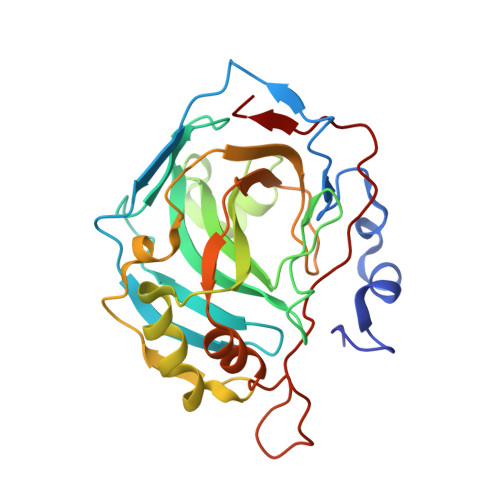Inhibition of carbonic anhydrase II by thioxolone: a mechanistic and structural study.
Barrese, A.A., Genis, C., Fisher, S.Z., Orwenyo, J.N., Kumara, M.T., Dutta, S.K., Phillips, E., Kiddle, J.J., Tu, C., Silverman, D.N., Govindasamy, L., Agbandje-McKenna, M., McKenna, R., Tripp, B.C.(2008) Biochemistry 47: 3174-3184
- PubMed: 18266323
- DOI: https://doi.org/10.1021/bi702385k
- Primary Citation of Related Structures:
2OSF, 2OSM - PubMed Abstract:
This paper examines the functional mechanism of thioxolone, a compound recently identified as a weak inhibitor of human carbonic anhydrase II by Iyer et al. (2006) J. Biomol. Screening 11, 782-791 . Thioxolone lacks sulfonamide, sulfamate, or hydroxamate functional groups that are typically found in therapeutic carbonic anhydrase (CA) inhibitors, such as acetazolamide. Analytical chemistry and biochemical methods were used to investigate the fate of thioxolone upon binding to CA II, including Michaelis-Menten kinetics of 4-nitrophenyl acetate esterase cleavage, liquid chromatography-mass spectrometry (LC-MS), oxygen-18 isotope exchange studies, and X-ray crystallography. Thioxolone is proposed to be a prodrug inhibitor that is cleaved via a CA II zinc-hydroxide mechanism known to catalyze the hydrolysis of esters. When thioxolone binds in the active site of CA II, it is cleaved and forms 4-mercaptobenzene-1,3-diol via the intermediate S-(2,4-thiophenyl)hydrogen thiocarbonate. The esterase cleavage product binds to the zinc active site via the thiol group and is therefore the active CA inhibitor, while the intermediate is located at the rim of the active-site cavity. The time-dependence of this inhibition reaction was investigated in detail. Because this type of prodrug inhibitor mechanism depends on cleavage of ester bonds, this class of inhibitors may have advantages over sulfonamides in determining isozyme specificity. A preliminary structure-activity relationship study with a series of structural analogues of thioxolone yielded similar estimates of inhibition constants for most compounds, although two compounds with bromine groups at the C1 carbon of thioxolone were not inhibitory, suggesting a possible steric effect.
- Department of Biological Sciences, Mailstop 5410, College of Arts and Sciences, 1903 West Michigan Avenue, Western Michigan University, Kalamazoo, Michigan 49008-5410, USA.
Organizational Affiliation:



















